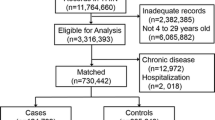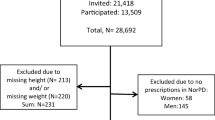Abstract
Studies suggest that long-term use of proton pump inhibitors (PPIs) may be associated with an increased risk of fracture. However, the role of medication adherence in this association is not fully understood. A retrospective cohort study was conducted to examine the relationship between PPI use/adherence and fracture risk among elderly subjects by combining administrative pharmacy claims data, survey data, and Medicare data. The study cohort included 1,604 PPI users and 23,672 nonusers who were enrolled in Pennsylvania’s Pharmaceutical Assistance Contract for the Elderly program. PPI adherence was measured by the proportion of days covered (PDC). Time-dependent Cox proportional hazards models were used to estimate adjusted hazard ratios (HRs) of PPI use/adherence for fracture risk while controlling for demographics, comorbidity, body mass index, smoking, and non-PPI medication use. The overall incidence of any fracture per 100 person-years was 8.7 for PPI users and 5.0 for nonusers. A gradient in fracture risk according to PPI adherence was observed. Relative to nonusers, fracture HRs associated with the highest (PDC ≥ 0.80), intermediate (PDC 0.40–0.79), and lowest (PDC <0.40) adherence levels were 1.46 (p < 0.0001), 1.30 (p = 0.02), and 0.95 (p = 0.75), respectively. In addition, the fracture risk of PPI use was significant for hip (HR = 1.32, p = 0.04) and vertebral (HR = 1.69, p = 0.0005) fractures, and risk was similar between major osteoporotic and other fractures. These results provide further evidence that PPI use may increase fracture risk in the elderly and highlight the need for clinicians to periodically reassess elderly patients’ individualized needs for ongoing PPI therapy, while weighing potential risks and benefits.

Similar content being viewed by others
References
Woolf AD, Akesson K (2003) Preventing fractures in elderly people. BMJ 327:89–95
Budhia S, Mikyas Y, Tang M, Badamgarav E (2012) Osteoporotic fractures: a systematic review of US healthcare costs and resource utilization. Pharmacoeconomics 30:147–170
Cummings SR, Melton LJ (2002) Epidemiology and outcomes of osteoporotic fractures. Lancet 359:1761–1767
Kanis JA, Johansson H, Oden A, McCloskey EV (2009) Assessment of fracture risk. Eur J Radiol 71:392–397
Cumming RG (1998) Epidemiology of medication-related falls and fractures in the elderly. Drugs Aging 12:43–53
Woolcott JC, Richardson KJ, Wiens MO, Patel B, Marin J, Khan KM, Marra CA (2009) Meta-analysis of the impact of 9 medication classes on falls in elderly persons. Arch Intern Med 169:1952–1960
Yang YX, Lewis JD, Epstein S, Metz DC (2006) Long-term proton pump inhibitor therapy and risk of hip fracture. JAMA 296:2947–2953
Vestergaard P, Rejnmark L, Mosekilde L (2006) Proton pump inhibitors, histamine H2 receptor antagonists, and other antacid medications and the risk of fracture. Calcif Tissue Int 79:76–83
Targownik LE, Lix LM, Metge CJ, Prior HJ, Leung S, Leslie WD (2008) Use of proton pump inhibitors and risk of osteoporosis-related fractures. CMAJ 179:319–326
Yu EW, Blackwell T, Ensrud KE, Hillier TA, Lane NE, Orwoll E, Bauer DC (2008) Acid-suppressive medications and risk of bone loss and fracture in older adults. Calcif Tissue Int 83:251–259
de Vries F, Cooper AL, Cockle SM, van Staa TP, Cooper C (2009) Fracture risk in patients receiving acid-suppressant medication alone and in combination with bisphosphonates. Osteoporos Int 20:1989–1998
Roux C, Briot K, Gossec L, Kolta S, Blenk T, Felsenberg D, Reid DM, Eastell R, Gluer CC (2009) Increase in vertebral fracture risk in postmenopausal women using omeprazole. Calcif Tissue Int 84:13–19
Corley DA, Kubo A, Zhao W, Quesenberry C (2010) Proton pump inhibitors and histamine-2 receptor antagonists are associated with hip fractures among at-risk patients. Gastroenterology 139:93–101
Gray SL, LaCroix AZ, Larson J, Robbins J, Cauley JA, Manson JE, Chen Z (2010) Proton pump inhibitor use, hip fracture, and change in bone mineral density in postmenopausal women: results from the Women’s Health Initiative. Arch Intern Med 170:765–771
Teramura-Grönblad M, Hosia-Randell H, Muurinen S, Pitkala K (2010) Use of proton-pump inhibitors and their associated risks among frail elderly nursing home residents. Scand J Prim Health Care 28:154–159
Pouwels S, Lalmohamed A, Souverein P, Cooper C, Veldt BJ, Leufkens HG, de Boer A, van Staa T, de Vries F (2011) Use of proton pump inhibitors and risk of hip/femur fracture: a population-based case–control study. Osteoporos Int 22:903–910
Khalili H, Huang ES, Jacobson BC, Camargo CA Jr, Feskanich D, Chan AT (2012) Use of proton pump inhibitors and risk of hip fracture in relation to dietary and lifestyle factors: a prospective cohort study. BMJ 344:e372
Mello M, Weideman RA, Little BB, Weideman MW, Cryer B, Brown GR (2012) Proton pump inhibitors increase the incidence of bone fractures in hepatitis C patients. Dig Dis Sci 57:2416–2422
IMS Institute for Healthcare Informatics (2010) Top therapeutic classes by U.S. dispensed prescription. IMS Health Web. http://www.imshealth.com/cds/ims/Global/Content/Corporate/Press%20Room/Top-line%20Market%20Data/2009%20Top-line%20Market%20Data/Top%20Therapy%20Classes%20by%20U.S.RXs.pdf. Accessed 7 Aug 2013
IMS Institute for Healthcare Informatics (2010) Top therapeutic classes by U.S. sales. IMS Health Web. http://www.imshealth.com/cds/ims/Global/Content/Corporate/Press%20Room/Top-line%20Market%20Data/2009%20Top-line%20Market%20Data/Top%20Therapy%20Classes%20by%20U.S.Sales.pdf. Accessed 7 Aug 2013
Aitken M, Kleinrock M (2013) Declining medicine use and costs: for better or worse? A review of the use of medicines in the United States in 2012. IMS Health Web. http://www.imshealth.com/cds/ims/Global/Content/Insights/IMS%20Institute%20for%20Healthcare%20Informatics/2012%20U.S.%20Medicines%20Report/2012_U.S.Medicines_Report.pdf. Accessed 7 Aug 2013
US Food and Drug Administration (2011) Proton pump inhibitors (PPI): class labeling change. http://www.fda.gov/Safety/MedWatch/SafetyInformation/SafetyAlertsforHumanMedicalProducts/ucm213321.htm. Accessed 7 Aug 2013
Kaye JA, Jick H (2008) Proton pump inhibitor use and risk of hip fractures in patients without major risk factors. Pharmacotherapy 28:951–959
Chen J, Yuan YC, Leontiadis GI, Howden CW (2012) Recent safety concerns with proton pump inhibitors. J Clin Gastroenterol 46:93–114
Kwok CS, Yeong JK, Loke YK (2011) Meta-analysis: risk of fractures with acid-suppressing medication. Bone 48:768–776
Targownik LE, Lix LM, Leung S, Leslie WD (2010) Proton-pump inhibitor use is not associated with osteoporosis or accelerated bone mineral density loss. Gastroenterology 138:896–904
Vermeire E, Hearnshaw H, Van Royen P, Denekens J (2001) Patient adherence to treatment: three decades of research. A comprehensive review. J Clin Pharm Ther 26:331–342
Osterberg L, Blaschke T (2005) Adherence to medication. N Engl J Med 353:487–497
Hill AB (1965) The environment and disease: association or causation? Proc R Soc Med 58:295–300
Leslie WD, Tsang JF, Caetano PA, Lix LM, Manitoba Bone Density Program (2007) Effectiveness of bone density measurement for predicting osteoporotic fractures in clinical practice. J Clin Endocrinol Metab 92:77–81
Martin BC, Wiley-Exley EK, Richards S, Domino ME, Carey TS, Sleath BL (2009) Contrasting measures of adherence with simple drug use, medication switching, and therapeutic duplication. Ann Pharmacother 43:36–44
Yeaw J, Benner JS, Walt JG, Sian S, Smith DB (2009) Comparing adherence and persistence across 6 chronic medication classes. J Manag Care Pharm 15:728–740
Wiens M, Etminan M, Gill SS, Takkouche B (2006) Effects of antihypertensive drug treatments on fracture outcomes: a meta-analysis of observational studies. J Intern Med 260:350–362
Boyle N, Naganathan V, Cumming RG (2010) Medication and falls: risk and optimization. Clin Geriatr Med 26:583–605
Bloch F, Thibaud M, Dugue B, Breque C, Rigaud AS, Kemoun G (2011) Psychotropic drugs and falls in the elderly people: updated literature review and meta-analysis. J Aging Health 23:329–346
Elixhauser A, Steiner C, Harris DR, Coffey RM (1998) Comorbidity measures for use with administrative data. Med Care 36:8–27
Shtatland ES, Kleinman K, Cain EM (2005) Model building in PROC PHREG with automatic variable selection and information criteria. In: Proceedings of the 30th Annual SAS Users Group International Conference. Paper 206–30. SAS Institute, Cary, NC
Eom CS, Park SM, Myung SK, Yun JM, Ahn JS (2011) Use of acid-suppressive drugs and risk of fracture: a meta-analysis of observational studies. Ann Fam Med 9:257–267
Ngamruengphong S, Leontiadis GI, Radhi S, Dentino A, Nugent K (2011) Proton pump inhibitors and risk of fracture: a systematic review and meta-analysis of observational studies. Am J Gastroenterol 106:1209–1218
Chia LR, Schlenk EA, Dunbar-Jacob J (2006) Effect of personal and cultural beliefs on medication adherence in the elderly. Drugs Aging 23:191–202
Simpson SH, Eurich DT, Majumdar SR, Padwal RS, Tsuyuki RT, Varney J, Johnson JA (2006) A meta-analysis of the association between adherence to drug therapy and mortality. BMJ 333:15–18
Targownik LE, Leslie WD, Davison KS, Goltzman D, Jamal SA, Kreiger N, Josse RG, Kaiser SM, Kovacs CS, Prior JC, Zhou W, CaMos Research Group (2012) The relationship between proton pump inhibitor use and longitudinal change in bone mineral density: a population-based study from the Canadian Multicentre Osteoporosis Study (CaMos). Am J Gastroenterol 107:1361–1369
Lau YT, Ahmed NN (2012) Fracture risk and bone mineral density reduction associated with proton pump inhibitors. Pharmacotherapy 32:67–79
Figura N, Gennari L, Merlotti D, Lenzi C, Campagna S, Franci B, Lucani B, Trabalzini L, Bianciardi L, Gonnelli C, Santucci A, Nut A (2005) Prevalence of Helicobacter pylori infection in male patients with osteoporosis and controls. Dig Dis Sci 50:847–852
Andrade SE, Kahler KH, Frech F, Chan KA (2006) Methods for evaluation of medication adherence and persistence using automated databases. Pharmacoepidemiol Drug Saf 15:565–574
Acknowledgements
All procedures followed were in accordance with the ethical standards of the responsible committee on human experimentation (institutional and national) and with the Helsinki Declaration of 1975, as revised in 2000. This report is based on the results of secondary data analysis that was conducted using existing administrative data files. The secondary linkage and use of these data was reviewed and approved by the Institutional Review Board of the Pennsylvania State University.
Author information
Authors and Affiliations
Corresponding author
Additional information
Authors Jian Ding, Debra A. Heller, Frank M. Ahern and Theresa V. Brown declare that they have no conflict of interest.
Rights and permissions
About this article
Cite this article
Ding, J., Heller, D.A., Ahern, F.M. et al. The Relationship Between Proton Pump Inhibitor Adherence and Fracture Risk in the Elderly. Calcif Tissue Int 94, 597–607 (2014). https://doi.org/10.1007/s00223-014-9855-6
Received:
Accepted:
Published:
Issue Date:
DOI: https://doi.org/10.1007/s00223-014-9855-6




